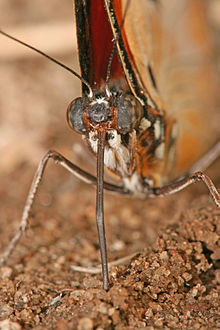Proboscis




A proboscis (/proʊˈbɒsɪs/) is an elongated appendage from the head of an animal, either a vertebrate or an invertebrate. In invertebrates, the term usually refers to tubular mouthparts used for feeding and sucking. In vertebrates, the term is used to describe an elongated nose or snout.
Etymology
First attested in English in 1609 from Latin proboscis, the latinisation of the Greek προβοσκίς (proboskis),[1] which comes from πρό (pro) "forth, forward, before"[2] + βόσκω (bosko), "to feed, to nourish".[3][4] The correct Greek plural is proboscides, but in English it is more common to simply add -es, forming proboscises.
Invertebrates
The most common usage is to refer to the tubular feeding and sucking organ of certain invertebrates such as insects (e.g., moths and butterflies), worms (including proboscis worms) and gastropod molluscs.
Lepidoptera mouth parts
The mouth parts of Lepidoptera mainly consist of the sucking kind; this part is known as the proboscis or 'haustellum'.The proboscis consists of two tubes held together by hooks and separable for cleaning. The proboscis contains muscles for operating. Each tube is inwardly concave, thus forming a central tube up which moisture is sucked. Suction takes place due to the contraction and expansion of a sac in the head.[5]
A few Lepidoptera species lack mouth parts and therefore do not feed in the imago. Others, such as the family Micropterigidae, have mouth parts of the chewing kind.[6]
Vertebrates
The elephant's trunk and the tapir's elongated nose are called "proboscis", as is the snout of the male elephant seal.
The Proboscis Monkey is named for its enormous nose, and an elongated human nose is sometimes facetiously called a proboscis.
An abnormal facial appendage that sometimes accompanies ocular and nasal abnormalities in humans is also called a proboscis.
Notable mammals with some form of proboscis are:
- Members of the elephant family (see elephant trunk).
- Moeritherium (extinct)
- Macrauchenia (extinct)
- Palorchestes (extinct)
- Aardvark
- Tapiridae
- Elephant shrews
- Numbat
- Proboscis Monkey
- Hispaniolan Solenodon
See also
References
- ^ προβοσκίς, Henry George Liddell, Robert S, A Greek-English Lexicon, on Perseus Digital Library
- ^ πρό, Henry George Liddell, Robert Scott, A Greek-English Lexicon, on Perseus Digital Library
- ^ βόσκω, Henry George Liddell, Robert Scott, A Greek-English Lexicon, on Perseus Digital Library
- ^ Online Etymology Dictionary
- ^ Evans, Identification of Indian Butterflies, Introduction, pp 1 to 35.
- ^ Charles A. Triplehorn and Norman F. Johnson (2005). Borror and Delong's Introduction to the Study of Insects (7th edition). Thomson Brooks/Cole, Belmont, CA. ISBN 0-03-096835-6
